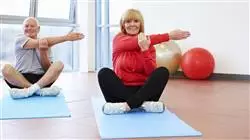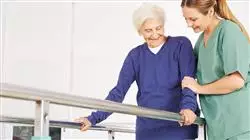University certificate
The world's largest faculty of physiotherapy”
Why study at TECH?
A study that will allow you to gain in-depth knowledge in the possibilities of the most current devices to support autonomy, with the most extensive understanding of their suitability and safe use in geriatric patients"

The incorporation of assistive devices for autonomy in physiotherapy work is an indispensable means of support and care for the patient. Finding the most suitable ones that offer the desired advantages is not so easy. What is needed is a complete assessment that takes into account the characteristics of each patient and their ability to handle and adapt to the devices.
To this end, the professional must assess and explore the patient's resistance and physiological reserves in order to establish the appropriate framework for action, home care, residential care, day care or social centers or private clinics.
This work should include treatments for pre-frailty, frailty, pain, trauma, neurological, respiratory and/or pelvic floor disorders, gerontological syndromes or cognitive impairment, side effects of drugs and/or biopsychosocial conditions that may complicate the clinical picture.
It is therefore essential to know the tools of physiotherapy and the appropriateness of its application in each case, such as active exercise, manual therapy and electrotherapy being able to work in an interdisciplinary team, with appropriate communication tools. Having an understanding of the concept of person-centered care, possessing the most up-to-date knowledge of support devices and even the support of current technology, can be key to success in the treatment of physiotherapy.
Incorporate the latest innovations in assistive devices, mobility and containment for the care of geriatric patients into your physical therapy practice"
This Postgraduate diploma in Application of Devices and Aids to Autonomy in Physical Therapy offers you the characteristics of a program of high scientific, teaching and technological level. These are some of its most notable features:
- The latest technology in online teaching software
- A highly visual teaching system, supported by graphic and schematic contents that are easy to assimilate and understand
- Practical cases presented by practising experts
- State-of-the-art interactive video systems
- Teaching supported by telepractice
- Continuous updating and recycling systems
- Autonomous learning: full compatibility with other occupations
- Practical exercises for self-evaluation and learning verification
- Support groups and educational synergies: questions to the expert, debate and knowledge forums
- Communication with the teacher and individual reflection work
- Content that is accessible from any fixed or portable device with an Internet connection
- Supplementary documentation databases are permanently available, even after the program
You will learn how to perform a proper assessment that will allow you to choose the most suitable systems for each patient with mobility problems"
The program’s teaching staff includes professionals from the sector who contribute their work experience to this program, as well as renowned specialists from leading societies and prestigious universities.
The multimedia content, developed with the latest educational technology, will provide the professional with situated and contextual learning, i.e., a simulated environment that will provide immersive learning programmed to train in real situations.
This program is designed around Problem Based Learning, whereby the professional must try to solve the different professional practice situations that arise during the academic year. For this purpose, the student will be assisted by an innovative interactive video system created by renowned and experienced experts.
A highly intensive course created to allow you to learn in a dynamic and effective way”

By means of the most efficient audiovisual systems, this Postgraduate diploma will allow you to learn through direct and realistic observations of what you learn”
Syllabus
Through the criteria of educational effectiveness that we offer you, and through a complete and specific syllabus, you will cover all the essential areas of learning proposed, gradually acquiring the skills required to put into practice what you have learnt. A very well-developed learning structure that is tailored to your needs and will allow you to learn in a continuous, efficient way.

A stimulating and intensive syllabus, organized into high-impact teaching units, which includes all aspects that rehabilitative medicine must consider in the care of frail patients"
Module 1. Clinical Reasoning in Physiogeriatrics
1.1. Past, Present and Future of Physiotherapy in Geriatrics
1.1.1. Brief History of Physiotherapy
1.1.1.1. Origin of physiotherapy Beyond our Borders
1.1.1.2. Origin of Physiotherapy
1.1.1.3. Conclusions
1.1.2. Current Situation of Physiotherapy in Geriatrics
1.1.3. Future of Physiotherapy in Geriatrics
1.1.3.1. Physiotherapy and New Technologies
1.2. Active Aging
1.2.1. Introduction
1.2.2. Concept of Active Aging
1.2.3. Classification
1.2.4. Active Aging from the Patients Point of View
1.2.5. Role of the Physical Therapist in Active Aging programs
1.2.6. Example of Intervention
1.3. Physiotherapy in Geriatrics and Context of Action
1.3.1. Introduction and Definitions
1.3.2. Fields of Action
1.3.2.1. Residential Centers
1.3.2.2. Socio-Sanitary
1.3.2.3. Primary Care
1.3.2.4. Physiotherapy in Palliative Care Units
1.3.3. Future Areas in Physiogeriatrics
1.3.3.1. New Technologies
1.3.3.2. Physiotherapy and Architecture
1.3.4. Interdisciplinary Teams in Geriatrics
1.3.4.1. Multidisciplinary or Interdisciplinary Teams?
1.3.4.2. Composition and Functioning of the Interdisciplinary Team
1.3.4.3. Main Functions within the Interdisciplinary Team
1.4. Differential Diagnosis and Warning Signs and Symptoms: Red and Yellow Flags in Geriatrics. Differential Diagnosis: Red and Yellow Flags
1.4.1. Introduction and Definitions
1.4.1.1. Differential Diagnosis
1.4.1.2. Diagnosis in Physiotherapy
1.4.1.3. Geriatric Syndromes
1.4.1.4. Red and Yellow Flags
1.4.2. Most Common Red Flags in Clinical Practice
1.4.2.1. Urinary Infection
1.4.2.2. Oncologic Pathology
1.4.2.3. Heart Failure
1.4.2.4. Fractures
1.5. Pharmacology: Effects on the Neuromusculoskeletal System
1.5.1. Introduction
1.5.1.1. Drugs Influencing Gait
1.5.2. Drugs and Risk of Falls
1.6. Approach to the Physical Therapy Session in Geriatrics
1.6.1. Physiotherapy Examination and Assessment of the Geriatric Patient
1.6.1.1. Valuation Components
1.6.1.2. Most Commonly Used Scales and Tests
1.6.2. Determination of Treatment Objectives
1.6.3. Organization of the Treatment Session
1.6.4. Organization of the Physiotherapist’s Own Work
1.6.5. Treatment Follow-Up in the Elderly Patient
Module 2. Updating in Support Devices for the Autonomy of People
2.1. Support Product Definition
2.1.1. Framework and Definition of Supporting Product
2.1.1.1. ISO 9999
2.1.1.2. EASTIN
2.1.2. What Characteristics Must Each Support Product (S.P.) Comply With?
2.1.3. Success in Optimal Product Support Advice
2.2. Updating of the Different Assistive Devices for the Activities of Daily Living
2.2.1. Facilitating Devices for Feeding
2.2.2. Dressing Aids
2.2.3. Facilitating Devices for Hygiene and Personal Care
2.3. Update on Different Pressure-Dissipating Devices for Pressure Ulcer Prevention
2.3.1. Sitting
2.3.2. Supine Position
2.3.3. Pressure Blanket Evaluation System
2.4. Transfers
2.4.1. Transfers and Mobilizations
2.4.1.1. Common Errors
2.4.1.2. Basic Guidelines for the Correct Use of the Different Devices
2.4.2. Device Upgrades
2.5. Novelties in the Different Devices Designed to Facilitate Mobility and Correct Positioning
2.5.1. General Framework
2.5.2. Mobility Devices in Geriatrics
2.5.2.1. Tilting Chair
2.5.2.2. Scooter
2.5.2.3. Electronic Driving Wheelchair
2.5.2.4. Relocation Assistance
2.5.2.5. Rear Walker
2.5.3. Positioning Devices in Geriatrics
2.5.3.1. Backups
2.5.3.2. Headrest
2.6. Personalized Devices for the Control of Wanderers, Plesoassistance
2.6.1. Definition of Plesioassistance or Control of Wanderers
2.6.2. Differences between Plesioassistance and Telecare
2.6.3. Objectives of Plesioassistance or Control of Wanderers
2.6.4. Components of the Plesioassistance Devices
2.6.5. Simple Wanderer Control Devices for Home Environments
2.6.6. Adaptation of the Environment to Facilitate the Wanderer's Orientation
2.6.7. Summary
2.7. Support Products for Recreation, Taking Advantage of Current Technologies
2.8. Upgrading of Accessibility Support Products and Architectural Barrier Removal Products
2.8.1. Framework for the Abolition of Architectural Barriers and Universal Access to Housing
2.8.2. Support Products for the Removal of Architectural Barriers in the Living Environment
2.8.2.1. Ramps
2.8.2.2. Lift Chairs
2.8.2.3. Inclined Elevated Platform
2.8.2.4. Overhead Crane
2.8.2.5. Short Travel Ladder Platform
2.8.2.6. Lifting Platform
2.8.2.7. Stair Climbing Devices
2.8.2.8. Convertible Ladder

A comprehensive study that will cover all the points of interest you need to update your rehabilitation intervention in geriatrics"
Postgraduate Diploma in the Application of Devices and Aids to Autonomy in Physiotherapy
Incorporating assistive devices for autonomy in physical therapy work is essential to provide support and care to the patient based on the specificities of his or her case. However, finding the most suitable ones, which offer the necessary advantages, is not a simple task. Thus, a complete assessment that takes into account the individual characteristics and capabilities of each patient is needed to determine the appropriate device, a task in which you will be updated with this Postgraduate Diploma in Application of Devices and Aids to Autonomy in Physiotherapy.
Master the decalogue of person-centered care with TECH
This Postgraduate Diploma in Application of Devices and Aids to Autonomy in Physical Therapy provides a comprehensive collection of up-to-date knowledge in this field of work, including new devices and protocols for the prescription and use of them. All this with the convenience of a flexible online format, in which you will not have to spend a single day in a face-to-face teaching center. Also, TECH gives you the opportunity to manage academic deadlines according to your own needs, so you can forget about sticking to cumbersome schedules that complicate your personal or professional obligations.







